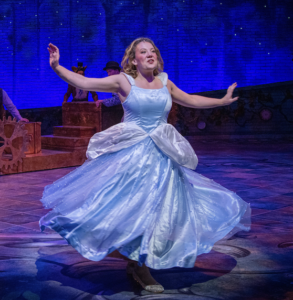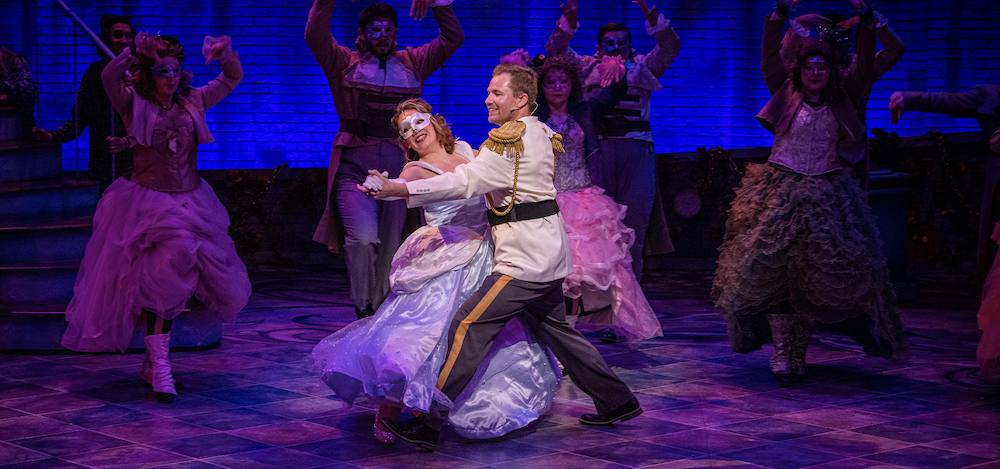Cinderella was onstage through December 23 at PCPA on the Allan Hancock College campus in Santa Maria.
So . . . it has magic, and marvelous voices, and zippy steps (with a few waltzes thrown in), but PCPA’s current production of Rodgers and Hammerstein’s Cinderella isn’t your traditional telling of the rags-to-royalty fairy tale of a girl who wins the heart of a prince because she’s beautiful and her dainty foot fits into an enchanted glass slipper.
No, that’s not this story at all.
This story’s book as written by Douglas Carter Beane for the musical’s first Broadway production in 2013 is based only partly on Hammerstein’s 1957 book, which was written for television, not the stage. In this plot, there are some surprises (as promised by director Erik Stein) that will certainly be unexpected, if not a bit jarring, to some audience members.

Prince Charming—here re-named Prince Topher (Samuel Lariviere)—is blind to the injustice in his kingdom, which he and his royal parents (now deceased) have left in the hands of a sinister prime minister (Andrew Philpot). And a new character, the rebel Jean-Michel (Oscar Emmanuel Fabela), is in love with one of Cinderella’s stepsisters, Gabrielle (Christen Celaya), who is depicted as more sympathetic to Cinderella’s plight than her stepsister Charlotte (Audrey Cirzan) and her mother (Kitty Balay). Jean-Michel wants to topple the government.
The show gets going after a curious, brief opening scene in which Cinderella (Faith Lennon Richter, more woman than girl in this version) finds her dead father’s jacket during some folderol involving her fairy godmother (Elizabeth Martinié) and six commedia dell’arte Zanies (Chris Coffey, Robin Castillo, Grace Kitchen, Alex Loder, Andrew Banderas, and Emmanuel Fuerte). But it doesn’t get on with the usual Cinderella story, at least at first. Instead, it veers to Prince Topher, giving him a backstory of personal confusion, and a song, “Me, Who Am I?,” that wasn’t in the original.
Yes, four songs (somewhat less memorable than the original songs, but all from the Rodgers and Hammerstein catalogue) have been added, mostly to move the novel political agenda of the plot along. Also, in an attempt to give Cinderella (and all those little girls out there who identify with her) more agency, her flight from the Prince’s ball at the stroke of midnight actually presents her an opportunity and a choice: instead of unwittingly leaving her glass slipper behind, she deliberately turns and places her shoe on the stair for him to find.

There are some reassuringly familiar pieces here: the truly wondrous Rodgers and Hammerstein tunes “In My Own Little Corner,” “Impossible,” “Ten Minutes Ago,” “Do I Love You Because You’re Beautiful?”—all performed with charm and grace by a truly talented cast. And of course it wouldn’t be the same story at all without the magic—the fairy godmother’s transformation of Cinderella’s ashcloth into a beautiful blue ball gown being one pleasing example.
PCPA’s renowned ability to create marvelous costumes (the stepmother’s red dress is a hoot), stage sets (in one word, enchanting), lighting (Jennifer “Z” Zornow at her best), and sound (so integral to a show like this) is on glorious display, as are the abilities of the company, all of whom, to a person, are warm and engaging and act like they are having the time of their lives.
Both Richter and Lariviere are charming (and yes, kind—a recurring theme in this show), as are Martinié (who gives the fairy in fairy godmother a good turn) and Fabela (who combines empathy and sympathy in his role, even if he is trying to overthrow “a corrupt system with no moral center”). Celaya and Cirzan create clever, comedic moments as the stepsisters who aren’t afraid to go after what they want, and Balay as the stepmother is in full-throated command of her daughters, and of the whole stage as well.
Musical highlights include Richter and Lariviere at the ball just after they meet “Ten Minutes Ago” in the first act (or rather, meet again, in this version), and the lovely, lyrical, laughing quartet of Richter, Celaya, Cirzan and Balay recalling “A Lovely Night.”
Costume designer Eddy L. Barrows, scenic designer Jason Bolen, sound designer Walter Clissen, musical director Paul Marszalkowski, and choreographer Keenon Hooks (who throws his delightful voice and toe-tapping feet into the mix as Lord Pinkleton as well) have produced some awesome handiwork here.
Stein has made some intriguing, if not altogether understandable, directorial choices while attempting to incorporate a harsh, decidedly political narrative into the arguably dated but tender fairy tale that parents and children mostly expect. The promised surprises include cute puppets who come to life, surreal dragons and monsters that Prince Topher dispatches easily, and the bachelor-style gifting of a rose that doesn’t quite hit the mark.
A suggestion: before you venture into this version of Cinderella’s story, you might read the director’s note in the PCPA program. “We have a need to revisit and share the stories we’ve heard before,” he writes. “Not because they are new, but because they are familiar.” This production asks us to reexamine some outdated tropes through the reworking of a familiar plot, which is in no way a bad thing. It’s just a little startling if you aren’t prepared for it.
